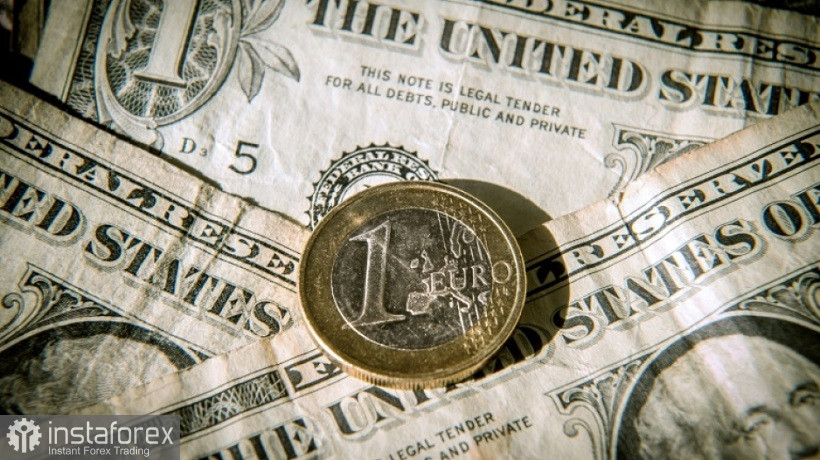The European Central Bank has just implemented the most hawkish of the previously discussed scenarios. The central bank decided not to take an unprecedented step by increasing the base interest rate on loans by 75 basis points to 1.25%. The remaining key rates - the rate on deposits and margin loans - the central bank raised from 0.00% to 0.75% and from 0.75% to 1.5%, respectively.
Let me remind you that ahead of the September meeting, not all experts were sure that the ECB was implementing such a hawkish scenario. Literally on Monday, journalists from the Reuters agency published a survey of 67 economists regarding the possible outcome of the upcoming meeting. The result was surprising: only half of those surveyed said that the ECB would increase the rate by 75 basis points. While 29 experts were sure that the central bank would only decide on a 50-point hike.
Therefore, as soon as the central bank announced its decision, the EUR/USD pair rallied and overcame the 1.0000 target, which no longer acts as a support level, but as a resistance level.

However, the upward momentum faded as soon as it began. Bulls could not hold their positions and could not develop a more or less significant correction, at least to the 1.0050 mark. And this despite the fact that the head of the ECB voiced very hawkish comments, confirming the course towards tightening monetary policy. ECB President Christine Lagarde made it clear that the central bank will raise rates, even despite the predicted deterioration of the economy in the European region.
So, the ECB, in fact, fulfilled the program to the maximum: it raised the rate by 75 points at once and declared a hawkish rate. What is the reason for such a weak reaction of the euro? By the way, after the ECB meeting, the single currency almost immediately weakened not only against the dollar, but also in many cross-pairs, in particular EUR/JPY and EUR/GBP.
Such a paradox, at first glance, the situation has developed for several reasons. As they say, the devil is in the details. In this particular case, in Lagarde's statements, who just commented on the results of the meeting. Firstly, she has limited the process of tightening monetary policy within the next six months. According to her, the ECB will need "more than two, but less than five meetings" to complete this process. Therefore, the hawkish scenario runs until next April at the most. Lagarde declined to talk about the pace of the rate hike, but added that a 75-point move is not the norm and the next hike "will not necessarily be 75 basis points."
That is, on the one hand, the ECB declared a hawkish rate, but at the same time clearly outlined the time horizon and did not talk about the pace of monetary tightening. At the same time, Lagarde disappointed EUR/USD bulls with the phrase that all subsequent decisions on the policy rate "will depend on incoming data."
Summing up all of the above, we can conclude that the ECB will increase rates within 2-4 meetings. But at what pace is unknown. And there is no consensus on the market about this. For example, economists polled by Bloomberg believe that the ECB will raise the deposit rate to 1.5% - at this level, experts see a "neutral" interest rate that does not stimulate or constrain the economy. At the same time, currency strategists at Commerzbank are more resolute. In their opinion, the ECB will raise the deposit rate to the target of 1.75% by the beginning of next year, after which it will pause for an indefinite period amid a recession.

Returning to the question of the future prospects for the EUR/USD pair, it should be recalled that almost two weeks before the September meeting of the ECB, Reuters published an insider report, according to which many members of the central bank were ready to support a 75-point rate hike at the end of August. Later, this insider was actually confirmed by some representatives of the central bank - in particular, the head of the Bundesbank, the chairman of the central bank of the Netherlands, as well as the head of the central bank of Estonia. But EUR/USD bulls reacted to the incoming information in a phlegmatic, reflexive and situational way: the upward price spikes subsided almost immediately. Therefore, it is not at all surprising that when persistent hawkish suggestions really materialized, the pair showed such a weak reaction.
In general, according to Thursday's results, we can safely state the obvious fact: the euro remains vulnerable, especially when paired with the US currency. The dollar confidently holds the defense amid growing hawkish expectations regarding the further actions of the Federal Reserve. By the way, the market listened not only to the comments of Lagarde, but also of Fed Chairman Jerome Powell. He sounded a very hawkish theses, saying that the central bank will act "straightforward and decisively" curbing inflation. Also, Powell said another interesting phrase: "history warns against premature easing of monetary policy." In general, the latest statements by Fed representatives (including Powell) are hawkish, suggesting that the US central bank will raise the rate in 75-point steps in September, November, and possibly even December.
Summarizing all of the above, we can conclude that short positions are still in priority for the EUR/USD pair. Bulls have not been able to find a foothold for the development of large-scale corrective growth (we are not talking about a trend reversal at all). It is advisable to enter shorts on the upward rollbacks - to the parity level or to the level of 1.0050. Downward targets are at 0.9950, 0.9900 and 0.9870.
 English
English 
 Русский
Русский Bahasa Indonesia
Bahasa Indonesia Bahasa Malay
Bahasa Malay ไทย
ไทย Español
Español Deutsch
Deutsch Български
Български Français
Français Tiếng Việt
Tiếng Việt 中文
中文 বাংলা
বাংলা हिन्दी
हिन्दी Čeština
Čeština Українська
Українська Română
Română

